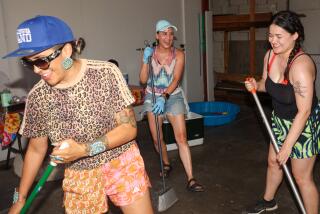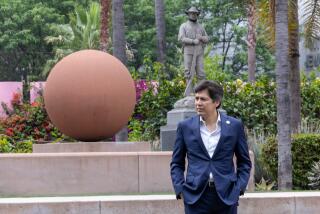Old Masonic Lodge: Past and Present Win Appreciation
- Share via
In the old days, the distinguished gentlemen of the Highland Park Masonic Lodge sat along the ornate paneled walls of their grand meeting room and listened to programs such as “Snappy Kidding Songs by Mr. Warner” and “Two Organisms Universally Feared and Hated by Man,” one of Alfred Cookman’s science talks.
These days, the handsome halls of the lodge--renamed, refurbished and added to the National Register of Historic Places--still echo with the sounds of popular entertainment in Highland Park, but the particulars have changed.
No longer a Masonic hall, the building at Avenue 56 and North Figueroa Street now houses the Highland Cultural Center, a community meeting place and banquet hall.
Up the sturdy stairway that in the 1920s welcomed 8-foot, 2-inch, 450-pound Masonic brother John Aasen, one of the lodge’s most memorable members, now skip the feet of Catholic girls celebrating quinceaneras , their 15th birthdays. Brides, TV producers and Playboy models, the Highland Park Chamber of Commerce and politicians of almost every leaning now admire the rare Victorian paneling and run their fingers softly along time-smoothed cherrywood.
Completed in 1923, the building ran the length of the block, featuring, as was typical for fraternal organizations, “spectacular” lodge and banquet rooms on the second floor and a row of retail outlets on the ground floor, said Christy Johnson McAvoy, a well-known preservation expert and consultant on the lodge’s restoration.
The arrangement gave the Masons a lavish meeting place while generating income from the shops on the ground floor, she said.
Now, as then, the solid brick building, with its beautiful frieze near the roof line, anchored a pivotal corner in Highland Park, McAvoy said. Security Pacific National Bank and Charlie Chan’s restaurant now share the intersection with the former Masonic building. A few doors down on Figueroa is the Highland Theater.
Occupying the former Masonic building, where a barbershop and a cafe once were, are the headquarters of Assemblyman Richard Polanco (D-Los Angeles) and a computer school. Project Head Start has a regional office over the Highland Cultural Center in the building.
The corner is a hub of activity, as it’s always been. On Friday afternoons, when people are banking and parties are setting up at the Highland Cultural Center, finding a parking space is nearly impossible, tenants say.
“The Mason building, along with the bank building and the theater, signaled the coming of age of the Highland Park community in the 1920s,” McAvoy said.
Keith Malone, a former member of the Masons’ youth group, the Order of DeMolay, remembers the building in its declining years during the late 1970s. The once-white banquet room walls had turned gray, and the elegant original chandeliers in the lodge room had been replaced by dull green 1950s-era fixtures that Malone said reminded him of inverted bottle caps.
Malone, now 27 and a press secretary to Polanco, said he was sorry to see the Masons leave in 1982, but has been impressed by the transformation of the building since then.
“Where our office stands now” on the first floor, along Avenue 56, “was a dingy sort of place we used to call ‘The Dungeon,’ ” he said.
“It’s all really quite beautiful now,” Malone said. “The building has served as a catalyst for redevelopment . . . in this stretch of Highland Park.”
McAvoy said the project was the first in the neighborhood to obtain historic designations that qualified its owners for tax breaks when they restored the building. Other historic structures are now being identified; the Security Pacific Bank nearby recently underwent remodeling and other projects are planned, signaling that renovation is catching on near the lodge.
But as is often the case with historical renovations, transformation of the one-time Masonic building into a cultural hall was slow and sometimes painful, McAvoy said.
The Masons were forced to abandon the building in 1982 because they could not afford to pay for earthquake renovations mandated by the city. Two Glendale stepbrothers, Jerry Manpearl and Jerry Sullivan, purchased the building and applied almost immediately for local, state and historic designations to help offset the estimated $400,000 cost of shoring up and restoring the hall’s interior and exterior.
Begun in 1985, the major work took three years. The old lodge room was left essentially intact but was rehung with antique light fixtures that the owners found at an auction. It was then renamed the Chandelier Room. Across the landing, the Masons’ banquet room was dubbed the Terrace Room. Its French doors open to a balcony overlooking Figueroa.
Sullivan, an engineer, oversaw the earthquake repairs, ensuring that period doorknobs and architectural detailing were not lost. Most important, he said, was preservation of intricate panels in the former lodge room. Called anaglyphs, they are made of embossed cotton on wallboard and represent a lost Victorian art form.
Reinforcement beams were attached to the outside, not the interior, of 18-inch-thick brick walls to preserve the interior; molding that had to be removed to reinforce walls with steel was painstakingly reassembled using saws and pocketknives.
Yet the project was not without its critics. Local historians balked when signs they considered intrusive and out of historic character were mounted outside, so they quickly came down. McAvoy and others regret the loss of an interior balcony, which was partially removed to accommodate third-floor offices occupied by Project Head Start.
Overall, though, McAvoy said the renovation work was of high-enough quality to earn the stamp of approval of the U.S. Department of the Interior, which judges projects on stringent restoration criteria.
By 1988, newly refinished doors were thrown open and on Jan. 18 this year, the old Masonic Hall, now the Highland Cultural Center, was added to the National Register of Historic Places.
Old iron restaurant stoves that once cooked steak-and-potato lodge dinners are more likely to warm canapes and tortillas for wedding receptions and anniversary celebrations.
Sun filtering through the lace curtains in the Terrace Room serves as natural photographic lighting for furniture ads and telephone commercials.
Secret doorways that might have been lost to the wrecking ball were incorporated into movie sets.
But the Masons who once conducted solemn ceremonies in the historic building rarely return.
If they ever stopped by for nostalgia’s sake, the Masons might be gratified to see the new shine on the doorknobs still embossed with Masonic symbols.
They might like to know that the manager, Tom Buford, is a Mason. He treasures yellowed letters that he found in the hall that recall good deeds of the Highland Park Masons of decades ago.
“I’m familiar with all this symbolism. I probably have a deeper appreciation for the place than somebody else might,” Buford said.
More to Read
Sign up for The Wild
We’ll help you find the best places to hike, bike and run, as well as the perfect silent spots for meditation and yoga.
You may occasionally receive promotional content from the Los Angeles Times.






